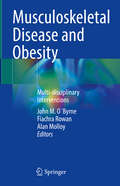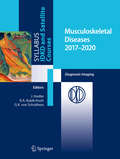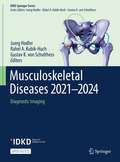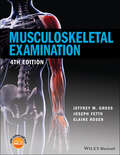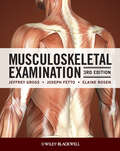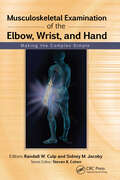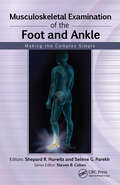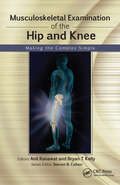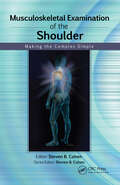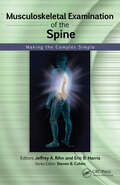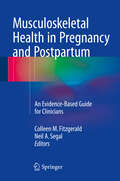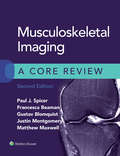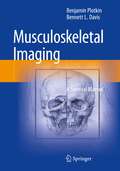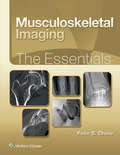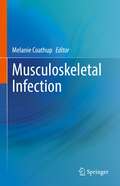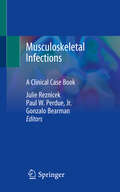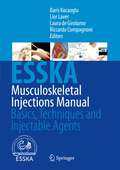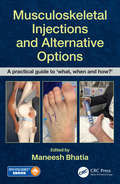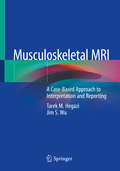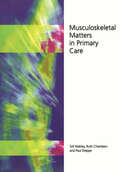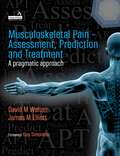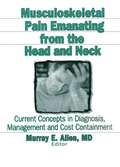- Table View
- List View
Musculoskeletal Disease and Obesity: Multi-disciplinary Interventions
by John M. O´Byrne Fiachra Rowan Alan MolloyThis book provides short chapters with key learning points from experts within the area, about musculoskeletal conditions in patients with obesity. Each chapter will be structured in two parts: (a) the increasing musculoskeletal conditions caused by the obesity and (b) the difficulty of treating the musculoskeletal conditions in the presence of obesity. It is aimed at a multidisciplinary readership including clinicians, physiotherapists, rehabilitation specialists, general practitioners and sports physicians, and other allied health professionals involved in the treatment of musculoskeletal disorders.
Musculoskeletal Diseases 2013–2016
by J. Hodler G. K. Schulthess Ch. L. ZollikoferWritten by internationally renowned experts, this updated volume is a collection of chapters dealing with imaging diagnosis and interventional therapies in musculoskeletal diseases. The different topics are disease-oriented and encompass all the relevant imaging modalities including X-ray technology, nuclear medicine, ultrasound and magnetic resonance, as well as image-guided interventional techniques. This publication, including excellent radiologic images and color illustrations, will appeal not only to radiologists, rheumatologists, orthopaedics surgeons, but also to clinicians in other specialties wishing to update their knowledge in this field.
Musculoskeletal Diseases 2017-2020
by Rahel A. Kubik-Huch Gustav K. von Schulthess Juerg HodlerThis book focuses on with musculoskeletal imaging: during the last few years, there have been considerable advances in this area, driven by clinical as well as technological developments. The authors, internationally renowned experts in their field, have contributed chapters that are disease-oriented and cover all relevant imaging modalities, including magnetic resonance imaging, computed tomography, and positron emission tomography. As a result, this book offers a comprehensive review of the state of the art in musculoskeletal imaging. It is a valuable resource for general radiologists, radiology residents, rheumatologists, orthopaedic surgeons, and clinicians from other specialities wishing to update their knowledge in this discipline.
Musculoskeletal Diseases 2021-2024: Diagnostic Imaging (IDKD Springer Series)
by Rahel A. Kubik-Huch Gustav K. von Schulthess Juerg HodlerThis open access book focuses on imaging of the musculoskeletal diseases. Over the last few years, there have been considerable advances in this area, driven by clinical as well as technological developments. The authors are all internationally renowned experts in their field. They are also excellent teachers, and provide didactically outstanding chapters. The book is disease-oriented and covers all relevant imaging modalities, with particular emphasis on magnetic resonance imaging. Important aspects of pediatric imaging are also included. IDKD books are completely re-written every four years. As a result, they offer a comprehensive review of the state of the art in imaging. The book is clearly structured with learning objectives, abstracts, subheadings, tables and take-home points, supported by design elements to help readers easily navigate through the text. As an IDKD book, it is particularly valuable for general radiologists, radiology residents, and interventional radiologists who want to update their diagnostic knowledge, and for clinicians interested in imaging as it relates to their specialty.
Musculoskeletal Examination
by Elaine Rosen Joseph Fetto Jeffrey M. GrossMusculoskeletal Examination is a user-friendly textbook on the techniques of physical examination. Written by a physiatrist, orthopedic surgeon, and physical therapist, it has a uniquely multidisciplinary approach. Musculoskeletal Examination covers the complete basic examination and basic principles of normal and abnormal musculoskeletal function are fully explained, leading you to the correct differential diagnosis. The new fourth edition is now in full colour throughout and includes over 750 detailed illustrations, X-rays and MRIs, and more than 100 photographs showing examination techniques. It also includes a companion website at www.wiley.com/go/musculoskeletalexam featuring 107 MCQs and links to videos demonstrating key examination methods.Musculoskeletal Examination is perfect as a quick reference guide, while the detailed descriptions and clinically relevant examples of frequently encountered conditions will help even the most novice practitioner gain the understanding necessary to make a correct diagnosis and determine a successful treatment plan. It is ideal for physical therapists, physiatrists, orthopedists, medical students, practitioners, and all those involved in sports medicine and clinical massage.
Musculoskeletal Examination
by Jeffrey Gross Elaine Rosen Joseph FettoMusculoskeletal Examination is a user-friendly textbook designed for students, physical therapists and physicians. It is uniquely multidisciplinary in its approach, being written by a physiatrist, physical therapist and orthopedist. With tables and boxed features to emphasize and summarize key concepts, and 'sample examination' boxes to highlight and test difficult areas, it is ideal for teaching introductory courses yet detailed enough for professional reference within clinical practice. It includes an easy-to-follow examination process for all the joints and spine, as well as combining biomechanics with physical examination to enhance understanding of function. This third edition includes more and better anatomy illustrations; over 850 illustrations, x-rays and MRIs are perfect as a quick reference guide, while the detailed descriptions and clinically relevant examples of frequently encountered conditions will help out even the most novice practitioner. The chapter on basic science, the brief overview of anatomy, and the introductory remarks at the start of each chapter that provide a biomechanical overview of the region featured, all ensure Musculoskeletal Examination will help you gain the understanding necessary to make a correct diagnosis and determine a successful treatment plan for your patients. Musculoskeletal Examination is ideal for physiotherapists, physiatrists, orthopedists, medical students, practitioners and all those involved in sports medicine and clinical massage.
Musculoskeletal Examination of the Elbow, Wrist, and Hand: Making the Complex Simple
by Randall Culp Sidney JacobyThe physical examination of the elbow, wrist, and hand can be a complex topic for professionals with all levels of clinical experience. How can advance concepts be taught in a user friendly, clear format, while still providing necessary information for effective diagnosis and treatment of the elbow, wrist, and hand?Musculoskeletal Examination of the Elbow, Wrist and Hand: Making the Complex Simple by Dr. Randall Culp answers these questions. Written by experts, this easy-to-carry book provides a thorough review of the most common pathologic elbow, wrist, and hand conditions, techniques for diagnosis, as well as the appropriate treatment for each condition.Musculoskeletal Examination of the Elbow, Wrist and Hand: Making the Complex Simple contains clear photographic demonstrations, tables, sidebars, and charts throughout its pages, allowing a thorough and concise examination of the elbow, wrist, and hand.A glance at what is covered inside: Physical Examination Basics and specific tests of the elbow, wrist, and hand General Imaging Basics of general imaging of the elbow, wrist, and hand Common Conditions Tendinopathy, arthritis, wounds, soft tissue injuries, and more Musculoskeletal Examination of the Elbow, Wrist and Hand: Making the Complex Simple contains essential information to successfully take a complex subject, and bring it to a level that will be welcomed by all orthopedic residents, attendings, physical therapists, athletic trainers, medical students in training, and other health care providers.
Musculoskeletal Examination of the Foot and Ankle: Making the Complex Simple
by Shepard Hurwitz Selene ParekhThe physical examination of the foot and ankle can be a complex topic for professionals with all levels of clinical experience. How can advance concepts be taught in a user-friendly, clear format, while still providing necessary information for effective diagnosis and treatment of the foot and ankle?Musculoskeletal Examination of the Foot and Ankle: Making the Complex Simple by Drs. Shepard Hurwitz and Selene Parekh answers these questions. Written by experts, this easy-to-carry book provides a quick and thorough review of the most common pathologic foot and ankle conditions, techniques for diagnosis, as well as the appropriate treatment for each condition.Musculoskeletal Examination of the Foot and Ankle: Making the Complex Simple contains clear photographic demonstrations, tables, sidebars, and charts throughout its pages, allowing a thorough and concise examination of the foot and ankle.A glance at some of what is covered inside:• Physical Examinationo Basics and specific tests of the foot and ankle• General Imagingo Basic interpretation of common imaging modalities of the foot and ankle• Common Conditionso Bunions, toe deformities, Achilles pathology and posterior calcaneal pain, fractures, plantar fasciitis and plantar heel pain, and moreMusculoskeletal Examination of the Foot and Ankle: Making the Complex Simple contains essential information to successfully take a complex subject, and bring it to a level that will be welcomed by orthopedic residents, faculty, physical therapists, athletic trainers, medical students interested in musculoskeletal health careers, and other health care providers.
Musculoskeletal Examination of the Hip and Knee: Making the Complex Simple
by Bryan Kelly Anil RanawatThe physical examination of the hip and knee can be a complex topic for professionals with all levels of clinical experience. How can advance concepts be taught in a user-friendly, clear format, while still providing necessary information for effective diagnosis and treatment of the hip and knee?Musculoskeletal Examination of the Hip and Knee: Making the Complex Simple by Drs. Anil Ranawat and Bryan T. Kelly answers these questions. Written by experts, this easy-to-carry book provides a thorough review of the most common pathologic hip and knee conditions, techniques for diagnosis, as well as the appropriate treatment for each condition.Musculoskeletal Examination of the Hip and Knee: Making the Complex Simple contains clear photographic demonstrations, tables, and charts throughout its pages, allowing a thorough and concise examination of the hip and knee.A glance at some of what is covered inside: Physical Examination Basics and specific tests of the physical examination of the hip and knee General Imaging Basics of general imaging of the hip and knee Common Conditions Arthroscopic management of labral tears, snapping hip syndromes, meniscal tears, and more Musculoskeletal Examination of the Hip and Knee: Making the Complex Simple contains essential information to successfully take a complex subject and bring it to a level that will be welcomed by orthopedic residents, attendings, physical therapists, athletic trainers, medical students in training, and other health care providers.
Musculoskeletal Examination of the Shoulder: Making the Complex Simple
by Steven CohenThe physical examination of the shoulder can be a complex topic for professionals with all levels of clinical experience. How can advance concepts be taught in a user-friendly, clear format, while still providing necessary information for effective diagnosis and treatment of the shoulder?Musculoskeletal Examination of the Shoulder: Making the Complex Simple by Dr. Steven B. Cohen answers these questions. Written by experts, this easy-to-carry book provides a thorough review of the most common pathologic shoulder conditions, techniques for diagnosis, as well as the appropriate treatment for each condition.Musculoskeletal Examination of the Shoulder: Making the Complex Simple contains clear photographic demonstrations, tables, and charts throughout its pages, allowing a thorough and concise examination of the shoulder.A glance at some of what is covered inside:• Physical Examinationo Basics and specific tests of the physical examination of the shoulder• General Imagingo Basics of general imaging of the shoulder• Common Conditions o Superior labrar tears, Biceps tendon, Glenohumeral arthritis, and moreMusculoskeletal Examination of the Shoulder: Making the Complex Simple contains essential information to successfully take a complex subject and bring it to a level that will be welcomed by orthopedic residents, attendings, physical therapists, athletic trainers, medical students in training, and other health care providers.
Musculoskeletal Examination of the Spine: Making the Complex Simple
by Eric Harris Jeffrey RihnThe physical examination of the spine can be a complex topic for professionals with all levels of clinical experience. How can advance concepts be taught in a user-friendly, clear format, while still providing necessary information for effective diagnosis and treatment of the spine?Musculoskeletal Examination of the Spine: Making the Complex Simple by Drs. Jeffrey A. Rihn and Eric B. Harris answers these questions. Written by experts, this easy-to-carry book provides a thorough review of the most common pathologic spine conditions, techniques for diagnosis, as well as the appropriate treatment for each condition.Musculoskeletal Examination of the Spine: Making the Complex Simple contains clear photographic demonstrations, tables, and charts throughout its pages, allowing a thorough and concise examination of the spine.A Glance at some of what is covered inside:• Physical Examinationo Basics and specific tests of the examination of the cervical and thoracolumbar spine• General Imagingo Basics of general imaging of the degenerative and traumatic injuries of the spine• Common Conditionso Cervical spondylosis, Lumbar disk herniation, Diskitis and vertebral osteomyelitis of the spine, and moreMusculoskeletal Examination of the Spine: Making the Complex Simple contains essential information to successfully take a complex subject, and bring it to a level that will be welcomed by all orthopedic residents, attendings, physical therapists, athletic trainers, medical students in training, and other healthcare providers.
Musculoskeletal Health in Pregnancy and Postpartum
by Colleen M. Fitzgerald Neil A. SegalProviding clinicians with a comprehensive, evidence-based summary of musculoskeletal health in pregnancy and postpartum, this is the first book of its kind to describe the physiologic changes, prevalence, etiology, diagnostic strategies, and effective treatments for the most common musculoskeletal clinical conditions encountered during this phase of life. Lumbopelvic pain, upper and lower extremity diagnoses, labor and delivery considerations, including the impact on the pelvic floor, and medical therapeutics will be discussed. Additionally, the importance and influence of exercise in pregnancy, the long-term implications of musculoskeletal health in pregnancy and current and future directions for research will be addressed. The childbearing period is a time of remarkable reproductive and musculoskeletal change, predisposing women to potential injury, pain, and resultant disability. Musculoskeletal Health in Pregnancy and Postpartum offers musculoskeletal medicine specialists, obstetricians and any clinicians involved in the care of pregnant or postpartum women the tools necessary to prepare for, treat and prevent these concurrent injuries during an already challenging time.
Musculoskeletal Health in Pregnancy and Postpartum: An Evidence-Based Guide for Clinicians
by Colleen M. Fitzgerald Neil A. SegalProviding clinicians with a comprehensive, evidence-based summary of musculoskeletal health in pregnancy and postpartum, this is the first book of its kind to describe the physiologic changes, prevalence, etiology, diagnostic strategies, and effective treatments for the most common musculoskeletal clinical conditions encountered during this phase of life. Lumbopelvic pain, upper and lower extremity diagnoses, labor and delivery considerations, including the impact on the pelvic floor, and medical therapeutics will be discussed. Additionally, the importance and influence of exercise in pregnancy, the long-term implications of musculoskeletal health in pregnancy and current and future directions for research will be addressed.The childbearing period is a time of remarkable reproductive and musculoskeletal change, predisposing women to potential injury, pain, and resultant disability. Musculoskeletal Health in Pregnancy and Postpartum offers musculoskeletal medicine specialists, obstetricians and any clinicians involved in the care of pregnant or postpartum women the tools necessary to prepare for, treat and prevent these concurrent injuries during an already challenging time.
Musculoskeletal Imaging: A Core Review
by Paul Spicer Francesca Beaman Gustav BlomquistPrepare for success on the musculoskeletal imaging component of the radiology Core Exam! Musculoskeletal Imaging: A Core Review, Second Edition, is an up-to-date, practical review tool written specifically for the Core Exam. This helpful resource contains 300 image-rich, multiple-choice questions with detailed explanations of right and wrong answers, fully revised content, high-yield tables for easy review, and additional eBook questions to ensure you’re ready for the Core Exam or recertification exam.
Musculoskeletal Imaging: A Survival Manual
by Benjamin Plotkin Bennett L. DavisThis book is a quick and focused review of musculoskeletal imaging essentials. The authors have spent many years teaching medical students, residents, and fellows, and have adapted a survival manual approach to optimize retention. They know that there are common and universal blind spots and gaps in recognition. With this book, the reader will learn where to look and what to look for. The authors highlight obvious and subtle findings that the reader will learn to recognize and understand, with a focus on the nuances that are essential to making accurate and pertinent interpretations.This book provides clear and concise instruction in identifying and communicating key and critical imaging findings. Chapters cover common conditions found in a busy emergency setting, as well as the more sedate settings of outpatient imaging, where potential pitfalls lurk. Abundant images reinforce the teaching points. Simple text cuts to the core of what is needed. Self-assessment modules and checklists reinforce learning and expose areas of weakness for further study.This is an ideal guide for radiology residents of all years and working radiologists who may need a refresher on one or more of the many facets of musculoskeletal imaging.
Musculoskeletal Imaging: A Teaching File (Lww Teaching File Ser.)
by Felix S. ChewPublisher's Note: Products purchased from 3rd Party sellers are not guaranteed by the Publisher for quality, authenticity, or access to any online entitlements included with the product. Perfect for residents to use during rotations, or as a quick review for practicing radiologists and fellows, Musculoskeletal Imaging: The Essentials is a complete, concise overview of the most important knowledge in this complex field. Each chapter begins with learning objectives and ends with board-style questions that help you focus your learning. A self-assessment examination at the end of the book tests your mastery of the content and prepares you for exams.
Musculoskeletal Infection
by Melanie CoathupThis book gathers international knowledge and contemporary clinical and scientific evidence on infections associated with the musculoskeletal system at a time when we are confronted with significant challenges and uncertainty. A key focus of the book is enhancing and advancing future discovery in the detection, prevention and treatment of musculoskeletal infection. This is an ideal book for physicians, surgeons, research scientists, university students, as well as medical and allied health students.
Musculoskeletal Infections: A Clinical Case Book
by Gonzalo Bearman Julie Reznicek Paul W. PerdueThis book aims to concisely present the most common types of musculoskeletal infections and demonstrate the key components of accurate diagnosis, treatment, and management. Written by experts in both infectious diseases and orthopaedics, the text takes a reader-friendly approach that is ideal for medical professionals in training as students or as seasoned practitioners strengthening their skills. Case chapters include a color clinical image as well as radiographic images for superior visual support. They conclude with 4-6 bulleted high yield points for quick reference and reader retention. The cases presented in Musculoskeletal Infections: A Clinical Case Bookprovide relevant and challenging diagnostic and management issues in musculoskeletal infectious disease, with an emphasis on clinical pearls and medical-surgical collaboration.
Musculoskeletal Injections Manual: Basics, Techniques and Injectable Agents
by Lior Laver Baris Kocaoglu Laura De Girolamo Riccardo CompagnoniThis book presents a comprehensive and updated overview of musculoskeletal injections with biologic and non-biologic injectable agents – a new trend of treatment in orthopaedics and sports medicine.This ESSKA book incorporates internal ongoing debates fostered by ESSKA U45 Committee and ESSKA’s Orthobiologics Initiative (ORBIT), which enroll a broad international group of dedicated clinicians and researchers. The topics covered mirror this fast evolving field which ranges from basic science knowledge to treatment options in sports traumatology. Renowned experts in the field examine and critically discuss each aspect, including existing controversies concerning indications and applications as well as the choice between biologic and non-biologic injections. Clear practical indications, subdivided by anatomical region and supported by a wealth of intra-procedural images, are aimed to support young surgeons in the application of musculoskeletal injections. Written by an international panel of clinicians and researchers, active in the field of orthobiology and sports medicine, this manual is an invaluable reference tool for all those involved in injectional therapies and sports traumatology.
Musculoskeletal Injections and Alternative Options: A practical guide to 'what, when and how?'
by Maneesh BhatiaMusculoskeletal injections for joint or tendon problems are performed commonly and their use, which can result in a marked improvement in acute symptoms as well as delay or postpone surgery, is on the rise. Key features: Provides concise, current and portable information Covers the latest treatment options, supported by scientific evidence and guidelines Discusses alternative injections, non-injection measures and novel treatment modalities Text supported by illustrations and video of injection procedures and physiotherapy Ideal for both the non-specialist seeking an introduction to the subject and the more experienced practitioner This accessible guide helps doctors from various disciplines including orthopaedics, sports medicine, rheumatology, radiology and primary care as well as allied health care professionals understand the indications and local anatomy to safely perform injections with complication avoidance. In addition, the book provides useful information regarding other alternatives including physiotherapy and novel modalities. The content is supported by current evidence, guidelines and companion videos.
Musculoskeletal MRI
by Asif Saifuddin Philippa Tyler Rikin HargunaniMusculoskeletal MRI covers the entire musculoskeletal system and related conditions, both common and rare. The text is neatly divided into sections based on the major anatomic divisions. Each section discusses anatomic subdivisions or joints, keeping sections on normal anatomy and pathologic findings close to each other, allowing radiologists to easily compare images of normal and pathologic findings. With more than 4000 high-quality MR images, information is presented in an easy-to-read bulleted format, providing the radiologist with all the information required to make an informed diagnosis in the clinical setting. The new edition also includes a complimentary eBook as well as access to image downloads. Comprehensive and user-friendly in its approach, the book provides every radiologist, both consultant and trainee, with increased confidence in their reporting.
Musculoskeletal MRI: A Case-Based Approach to Interpretation and Reporting
by Jim S. Wu Tarek M. HegaziThis book teaches readers how to interpret, read, and dictate musculoskeletal (MSK) MRI studies through a series of very high yield MSK MRI cases. The amount of knowledge needed to practice radiology can be daunting. This is especially true when the radiologist has to read studies in a subspecialty outside their expertise such as MSK MRI where there are numerous disease entities and complex imaging findings to navigate. Learning how to read MSK MRI studies is often taught during a lengthy fellowship; however, many radiologists do not have this additional training but must read MSK studies during their routine clinical practice. This book fills that educational gap for practicing radiologists faced with musculoskeletal MRIs. The cases in the book focus on the conditions that radiologists encounter most frequently in their daily clinical work, making it very high yield for the amount of time needed to read it. Written by experts from Harvard Medical School, the cases are organized by joints (shoulder, elbow, wrist/hand, pelvis/hip, knee, foot/ankle). Four additional chapters discussing arthritis, infection, bone marrow and tumors are also included. Each case begins with carefully selected high quality MRI images accompanied by a brief clinical vignette. Next, a concise report (as if one is dictating an official report) describing the imaging findings, diagnosis, and recommendations for management are provided. This sample dictation offers readers direct examples of how to report their own cases. Lastly, at the end of each case, there is a brief discussion section which mimics teaching sessions that would occur between specialist trainees and faculty members at the workstation so as to enable the readers to think like a bone radiologist. This book is an ideal guide for anyone who deals with MSK MRI on a regular basis, including general radiologists who have not completed a dedicated musculoskeletal radiology fellowship, radiologists who would want to brush up on their MSK MRI reading and reporting skills, and MSK radiology fellows and residents.
Musculoskeletal Matters in Primary Care
by Paul Dieppe Ruth Chambers Gill WakleyWidespread recognition of the benefits of minimally invasive procedures in surgery and medicine is resulting in the rapid development of new advances and new techniques in every speciality. This series of books sets out to meet the needs of those responsible for applying the techniques. This volume deals with the field of minimal access gynaecology. Areas covered and techniques described include: advances in instrumentation and equipment for minimal access surgery; operative endoscopy in the treatment of infertility; laparoscopic assisted vaginal hysterectomy and total laparoscopic hysterectomy; advancements in laser fibre optic delivery systems compared to existing electrosurgery techniques; and operative hysteroscopy with electricity.
Musculoskeletal Pain - Assessment, Prediction and Treatment
by David Walton Jim ElliottMusculoskeletal Pain - Assessment, Prediction and Treatment presents a common sense approach to interpreting and applying existing clinical knowledge and new research to help clinicians make sense of the complex phenomena of acute and chronic post-traumatic musculoskeletal pain. Built upon the Assess, Predict, Treat framework, the authors offer a method to help clinicians better understand their patients' pain. They present evidence-based decision tools to predict the natural and clinical course of common conditions, such as neck and low back pain, and they then synthesize that information into a logical, integrated treatment approach, which respects the individuality of the patient, the experiences of the clinician, and the value of evidence-informed practice.David Walton and James Elliott are leaders in the field of post-traumatic pain and recovery. Their work provides a valuable framework to facilitate novice clinicians in their transition towards experts and helps mid- and late-stage clinicians better interpret, synthesize, and discuss complex information on pain with the goal of optimised outcomes for patients.
Musculoskeletal Pain Emanating From the Head and Neck: Current Concepts in Diagnosis, Management, and Cost Containment
by Irwin J Russell Murray E AllenIt has been around since the first rear-impact automobile accident and it will continue to be a problem as long as humans have large, heavy heads perched on slender, highly mobile cervical spines. The subject is whiplash, and some of the brightest minds on the topic gathered in Banff, Alberta, Canada, for the Eighth International Symposium by the Physical Medicine Research Foundation. Editor Dr. Murray E. Allen, Chairman of the Symposium, has collected the findings in Musculoskeletal Pain Emanating From the Head and Neck: Current Concepts in Diagnosis, Management, and Cost Containment to help physicians, physical therapists, chiropractors, and researchers better understand “the new whiplash,” make reliable clinical assessments, and provide more effective treatment.This thorough collection includes bump studies with human volunteers, research into safer automobile seat backs and head restraints, postmortem cervical spine examinations, reviews of the literature, and other investigations from around the world. Readers of Musculoskeletal Pain Emanating From the Head and Neck will learn specifically about: injury mechanisms, threshold for injury, and impact severity long-term outcomes of whiplash injury psychological aspects of chronic pain and disability dizziness, imbalance, and chronic incapacity intervertebral joint injuries and cervical synovial joint injuries the Neck Disability Index manipulation and mobilization therapies temporomandibular disorders/temporomandibular pain and dysfunction syndrome (TMPDS)Musculoskeletal Pain Emanating From the Head and Neck is not simply a collection of studies presenting data and findings--rather, it is a compilation of knowledge that illuminates the challenges of treating whiplash and makes some strong and straightforward recommendations for improvement. The contributors and the editor stress to the reader that in order to provide the best possible care, providers must be alert to the many secondary manifestations of whiplash, test for the perception of dysfunction, and be reassuring whenever possible. They must foster an atmosphere of confidence, encourage very early activation, and help persons maintain the momentum of their lives. Furthermore, Dr. Allen calls for caregivers to stop most (if not all) drug treatments, avoid passive failure-mode treatments, and avoid prolonged medicalization of any form of treatment. By studying the findings and following the recommendations of the international experts contributing to Musculoskeletal Pain Emanating From the Head and Neck, physicians, chiropractors, and physical therapists will foster self-reliance in their patients and improve diagnosis, treatment, and cost containment of whiplash.
